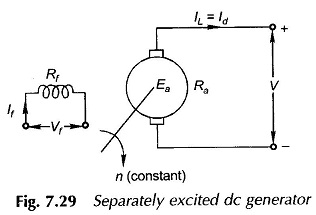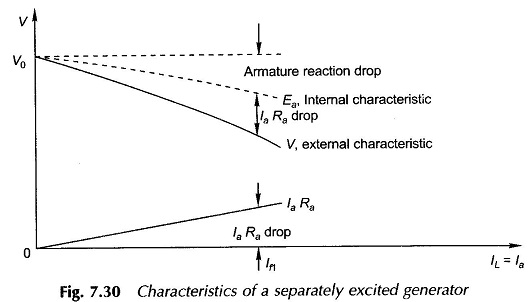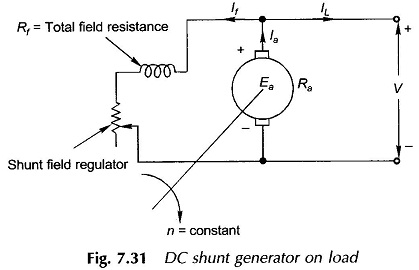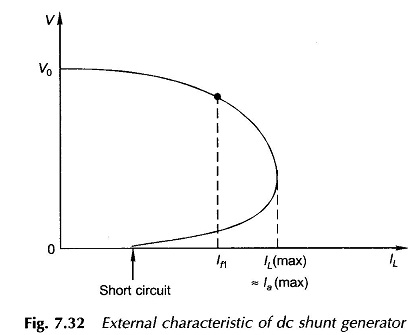Characteristics of Separately Excited DC Generator:
With the advent of silicon-controlled rectifiers, the importance of the dc machine as a generator has considerably reduced as SCRs can be employed to draw dc power from standard ac supply and convert it to dc; also the dc voltage can also be varied with ease. For the sake of completeness the Characteristics of Separately Excited DC Generator will be briefly discussed here, which are still found in older installations in industry (as a motor-generator set for speed control of dc motors).
The load Characteristics of Separately Excited DC Generator at a particular speed is the relationship between its terminal voltage and load current (line current) and is also termed as the external characteristic. The internal characteristic is the plot between the generated emf and load current.
Separately Excited DC Generator:
Figure 7.29 is that of a separately-excited dc generator. The operation considered here assumes that the armature is driven at constant speed (by means of prime mover) and the field excitation (If) is adjusted to give rated voltage at no-load and is then held constant at this value throughout the operation considered. The armature circuit is governed by the equation
In spite of fixed excitation, Ea drops off with load owing to the demagnetizing effect of the armature reaction. As the voltage drop is caused by magnetic saturation effect, it increases with load nonlinearity. The internal characteristic (Ea – IL) is shown dotted in Fig. 7.30. The external characteristic differs from the internal by the armature voltage drop IaRa which is also shown in Fig. 7.30.
Voltage Regulation:
The voltage regulation of a generator (independent of the kind of excitation employed) is defined as
Shunt Generator:
A dc shunt generator is a self-excited generator. The phenomenon of voltage build-up on no-load and the conditions necessary for the same have already been discussed earlier. Figure 7.31 shows a shunt-connected generator. With field resistance adjusted to a certain value by means of the regulating resistance, the desired no-load voltage can be obtained. The external characteristic of the generator can then be obtained by a load test with total field resistance remaining fixed in the process.
The terminal voltage drops off much more rapidly with load in a shunt generator than in a Characteristics of Separately Excited DC Generator because of fall in field current with terminal voltage. The external characteristic is a double-valued curve with a certain IL (max) as shown in Fig. 7.32. The internal characteristic can then be obtained from it by adding IaRa drop at several load points. As indicated in Fig. 7.32, the useful parts of the external characteristic is much before the turning point.




